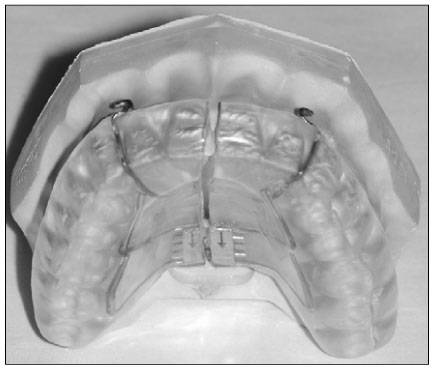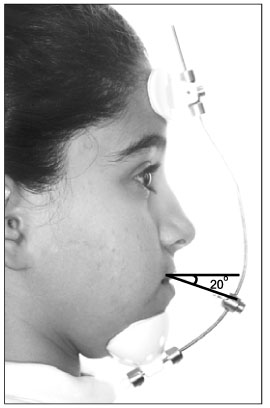Korean J Orthod.
2010 Dec;40(6):432-443. 10.4041/kjod.2010.40.6.432.
Effects of conventional and modified facemask therapies on dentofacial structures
- Affiliations
-
- 1Research Assistant, Department of Orthodontics, Faculty of Dentistry, Erciyes University, Kayseri, Turkey. dtahmetyagci@hotmail.com.
- 2Associate Professor and Chair, Department of Orthodontics, Faculty of Dentistry, Erciyes University, Kayseri, Turkey and Visiting Professor, King Saud University, Riyadh, Saudi Arabia.
- KMID: 1459545
- DOI: http://doi.org/10.4041/kjod.2010.40.6.432
Abstract
OBJECTIVE
The purpose of this prospective study was to evaluate the dentofacial effects of conventional and modified facemask therapies with rapid maxillary expansion, in a group of Class III patients; and compared with an untreated control group.
METHODS
The conventional facemask group (Group 1) comprised of 24 patients, 13 girls and 11 boys (mean age, 9.2 +/- 1.4 years); the modified facemask treatment group (Group 2) comprised of 24 patients, 12 girls and 12 boys (mean age, 9.3 +/- 1.6 years); and the control group (Group 3) comprised of 21 subjects, 11 girls and 10 boys (mean age, 9.8 +/- 1.9 years). Treatment and control changes within the groups and the differences between the groups were analyzed statistically. Intra-group comparisons were evaluated using the non-parametric Wilcoxon's test and intergroup changes were analyzed using the Kruskal-Wallis test. The statistical significance of intergroup differences was further assessed with the Mann-Whitney test for independent samples and applying Bonferroni's correction (p < 0.016).
RESULTS
In group 1, SNB changes were less than the control. There were increases in SNA, ANB, SN-MP, A to N perp and Upper lip to E plane. In group 2, SNB, U1-NA (mm) U1-NA (degrees) and Pog to N perp (mm) changes were less than the control. There were increases in SNA, ANB, SN-MP, A to N perp and Upper lip to E plane.
CONCLUSIONS
Modified facemask appliance can be used effectively in Class III patients with a retrognathic maxilla. Facemask therapies with expansion resulted in an anterior advancement and translation of maxilla without rotation; and the mandible moved downward and backward in both treatment groups.
Keyword
MeSH Terms
Figure
Reference
-
1. Ngan P, Hägg U, Yiu C, Merwin D, Wei SH. Soft tissue and dentoskeletal profile changes associated with maxillary expansion and protraction headgear treatment. Am J Orthod Dentofacial Orthop. 1996. 109:38–49.
Article2. Guyer EC, Ellis EE 3rd, McNamara JA Jr, Behrents RG. Components of class III malocclusion in juveniles and adolescents. Angle Orthod. 1986. 56:7–30.3. Ellis E 3rd, McNamara JA Jr. Components of adult Class III malocclusion. J Oral Maxillofac Surg. 1984. 42:295–305.
Article4. Jackson GW, Kokich VG, Shapiro PA. Experimental and postexperimental response to anteriorly directed extraoral force in young Macaca nemestrina. Am J Orthod. 1979. 75:318–333.
Article5. Kambara T. Dentofacial changes produced by extraoral forward force in the Macaca irus. Am J Orthod. 1977. 71:249–277.
Article6. Keles A, Tokmak EC, Erverdi N, Nanda R. Effect of varying the force direction on maxillary orthopedic protraction. Angle Orthod. 2002. 72:387–396.7. Mermigos J, Full CA, Andreasen G. Protraction of the maxillofacial complex. Am J Orthod Dentofacial Orthop. 1990. 98:47–55.
Article8. McNamara JA Jr, Brudon WL. Orthodontic and orthopedic treatment in the mixed dentition. 1993. Ann Arbor, MI: Needham Press;285–293.9. Hickham JH. Maxillary protraction therapy: diagnosis and treatment. J Clin Orthod. 1991. 25:102–113.10. Ishii H, Morita S, Takeuchi Y, Nakamura S. Treatment effect of combined maxillary protraction and chincap appliance in severe skeletal Class III cases. Am J Orthod Dentofacial Orthop. 1987. 92:304–312.
Article11. Hata S, Itoh T, Nakagawa M, Kamogashira K, Ichikawa K, Matsumoto M, et al. Biomechanical effects of maxillary protraction on the craniofacial complex. Am J Orthod Dentofacial Orthop. 1987. 91:305–311.
Article12. Nanda R. Biomechanical and clinical considerations of a modified protraction headgear. Am J Orthod. 1980. 78:125–139.
Article13. Alcan T, Keles A, Erverdi N. The effects of a modified protraction headgear on maxilla. Am J Orthod Dentofacial Orthop. 2000. 117:27–38.
Article14. Göyenç Y, Ersoy S. The effect of a modified reverse headgear force applied with a facebow on the dentofacial structures. Eur J Orthod. 2004. 26:51–57.
Article15. Petit H. McNamara JA, Ribbens KA, Howe RP, editors. Adaptations following accelerated facial mask therapy. Clinical alteration of the growing face. 1983. Ann Arbor: Center for Human Growth and Development, University of Michigan;48–59. Monograph no. 14, Craniofacial growth series.16. Erbay EF, Caniklioğlu CM, Erbay SK. Soft tissue profile in Anatolian Turkish adults: Part I. Evaluation of horizontal lip position using different soft tissue analyses. Am J Orthod Dentofacial Orthop. 2002. 121:57–64.
Article17. Swlerenga D, Oesterle LJ, Messersmith ML. Cephalometric values for adult Mexican-Americans. Am J Orthod Dentofacial Orthop. 1994. 106:146–155.18. Takada K, Petdachai S, Sakuda M. Changes in dentofacial morphology in skeletal Class III children treated by a modified maxillary protraction headgear and a chin cup: a longitudinal cephalometric appraisal. Eur J Orthod. 1993. 15:211–221.
Article19. Kapust AJ, Sinclair PM, Turley PK. Cephalometric effects of face mask/expansion therapy in Class III children: a comparison of three age groups. Am J Orthod Dentofacial Orthop. 1998. 113:204–212.20. Kajiyama K, Murakami T, Suzuki A. Comparison of orthodontic and orthopedic effects of a modified maxillary protractor between deciduous and early mixed dentitions. Am J Orthod Dentofacial Orthop. 2004. 126:23–32.
Article21. Baccetti T, Franchi L, McNamara JA Jr. Treatment and posttreatment craniofacial changes after rapid maxillary expansion and facemask therapy. Am J Orthod Dentofacial Orthop. 2000. 118:404–413.
Article22. Baik HS. Clinical results of the maxillary protraction in Korean children. Am J Orthod Dentofacial Orthop. 1995. 108:583–592.
Article23. Yüksel S, Uçem TT, Keykubat A. Early and late facemask therapy. Eur J Orthod. 2001. 23:559–568.
Article24. Merwin D, Ngan P, Hagg U, Yiu C, Wei SH. Timing for effective application of anteriorly directed orthopedic force to the maxilla. Am J Orthod Dentofacial Orthop. 1997. 112:292–299.
Article25. Proffit WR, Fields HW. Contemporary orthodontics. 1993. St Louis: Mosby;456–459.26. Haas AJ. The treatment of maxillary deficiency by opening the midpalatal suture. Angle Orthod. 1965. 35:200–217.27. Kiliçoglu H, Kirliç Y. Profile changes in patients with class III malocclusions after Delaire mask therapy. Am J Orthod Dentofacial Orthop. 1998. 113:453–462.
Article28. Battagel JM, Orton HS. Class III malocclusion: the post-retention findings following a non-extraction treatment approach. Eur J Orthod. 1993. 15:45–55.
Article29. Macdonald KE, Kapust AJ, Turley PK. Cephalometric changes after the correction of class III malocclusion with maxillary expansion/facemask therapy. Am J Orthod Dentofacial Orthop. 1999. 116:13–24.
Article30. Ngan P, Wei SH, Hagg U, Yiu CK, Merwin D, Stickel B. Effect of protraction headgear on Class III malocclusion. Quintessence Int. 1992. 23:197–207.
- Full Text Links
- Actions
-
Cited
- CITED
-
- Close
- Share
- Similar articles
-
- Comparison of the effects on the pharyngeal airway space of maxillary protraction appliances according to the methods of anchorage
- Evaluation of Palatal Rugae Following Orthopedic Treatment Using Rapid Maxillary Expander and Facemask
- Zygomatic miniplates for skeletal anchorage in orthopedic correction of Class III malocclusion: A controlled clinical trial
- Modified LeFort III osteotomy for mandibular prognathism with maxillary-malar deficiency: A case report
- A statistical study on the correlation between the nasopharyngeal space and the dentofacial structures






